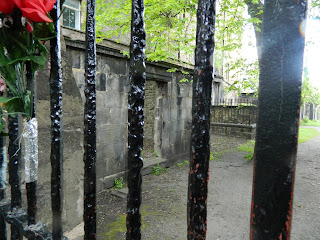 We are back in the footsteps of John Wesley today as we set off for Edinburgh. George Whitfield was invited to preach in the City by Rev Alexander Webster - he came a further 13 times after shaking the city with his message. Approx 20,000 people came to hear Whitfield about half the population of the city at the time came to Parliament square, outside St Giles, and we are told that multitudes were converted and transformed. Encouraged by Whitfield John Wesley preached 22 times between 1751 & 1790 and also had a good reception. His journal records that the only danger he had was of being hugged to death by the grateful citizens of Edinburgh! Another account relates to when he preached by the castle, which was our destination today. It was here that Wesley was arrested by two policemen on the charge of kidnapping someone. He was taken to Tolbooth Prison and held until the confusion was cleared up, when his accuser was fined £400 Scottish pounds - about £1000 today for slander.
We are back in the footsteps of John Wesley today as we set off for Edinburgh. George Whitfield was invited to preach in the City by Rev Alexander Webster - he came a further 13 times after shaking the city with his message. Approx 20,000 people came to hear Whitfield about half the population of the city at the time came to Parliament square, outside St Giles, and we are told that multitudes were converted and transformed. Encouraged by Whitfield John Wesley preached 22 times between 1751 & 1790 and also had a good reception. His journal records that the only danger he had was of being hugged to death by the grateful citizens of Edinburgh! Another account relates to when he preached by the castle, which was our destination today. It was here that Wesley was arrested by two policemen on the charge of kidnapping someone. He was taken to Tolbooth Prison and held until the confusion was cleared up, when his accuser was fined £400 Scottish pounds - about £1000 today for slander.The road from the castle leading into the original high street to the Hoyrood Palace is called "The royal mile" It has been a hotbed of spirituality and philosophy that has in different ways shaped the globe and we intend to explore some of it over the next few days.
As we arrive at the castle, construction workers are setting up the stands for Edinburgh Tattoo, a major construction project, and reflects that over the centuries the castle has stood at the heart of the city life as well as being one of the oldest fortified places in Europe, and has been occupied for thousands of years and the castle today took shape. The oldest building is St Margaret's Chapel built 1130c by King David I as a private royal chapel, dedicated to his mother, who was canonised as a saint in 1250. this was the only building allowed to remain after Robert Bruce ordered the castle to be destroyed in 1314 so not to be of any use to the English. Certainly people in the Bronze Age were living on the great rock and by the first centuries AD it was home to an Iron Age chief. The Picts, Scots, Britons and Angles had a role in shaping the fortress.
The Price of Freedom
The Scottish Reformation in many ways was triggered by the burning at the stake of Abbot Patrick Hamilton in 1528, he had studied in Germany and brought "Reformation ideas" to Scotland. He spoke at his burning about the forgiveness of sin and eternal life through Christ alone. Greyfriars Monks (Franciscans) and Blackfriars (Dominicans) started to publicly preach against pride and the idle life of Bishops and the abuses of the Church. At the same time St Andrew University started to explore the same thinking and ideas. John Knox also came across the preaching of the "Reformers" which challenged his thinking and in 1559 gave a series of sermons against papistry, idolatry, tyranny and superstition and in 1560 became minister of St Giles church. In Scotland the English Bible had been banned and it is recorded that "The town of Edinburgh, for the most part was drowned in superstition". On 28th February, 1538, six were also burnt on Castle Hill, their crime had been to preach through a Passion Play about the life of Christ to a illiterate audience. One hundred years later a document was signed by all the church leaders in the city called the National Covenant listing the errors of the Catholic Church. They were concerned that King Charles policies would return the
 |
| Greyfriars Church |
nation to "papal tyranny" The document was signed in Greyfriars Kirk by the barons and nobles, and clergy and merchants and copies given to all the churches in Edinburgh. When Charles II was made king he decided to become head of The Church of Scotland and declared that all private gatherings (Conventicles) of Christians unlawful and persecuting the Church. from 1670 the "Killing Times" in which 18,000 Covenanters died, 100 in Edinburgh just for praying together and practising their faith. In the battle of Bothwell Brig in 1679, those Covenanters who took a military stand were defeated,
 |
| Covenanters Prison Cells |
1400 survivors were taken to a makeshift prison next to Greyfriars Kirk and hured into what has been described as the world's first concentration camp many dying of suffocation, the rest executed or sold into slavery, where most died in a shipwreck. It wasn't until 1688, when William of Orange became King that ensured freedom of speech and religious freedom.
No comments:
Post a Comment